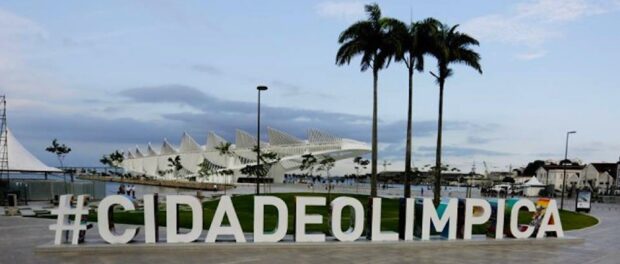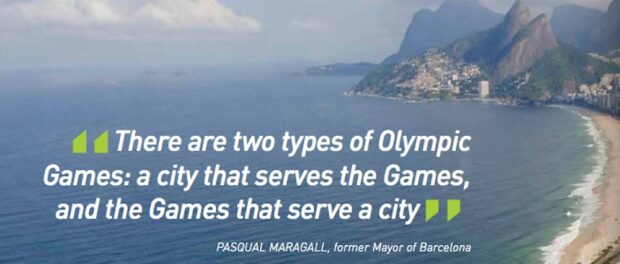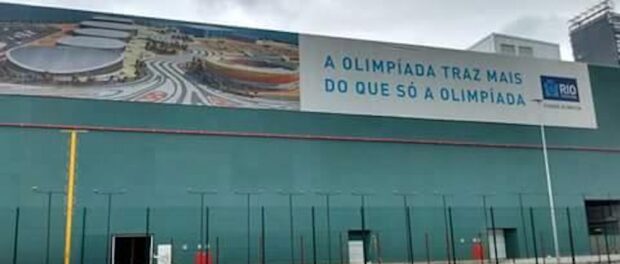
“To deliver excellent Games, with memorable celebrations, that will enhance the global image of Brazil and promote sustainable social and urban transformations through sport, contributing to the growth of the Olympic and Paralympic Movements.” — Rio 2016 mission statement
“The Rio 2016 Olympics will be the ultimate Legacy Games.” — City of Rio
Building on a trend developed at recent mega-events, the city of Rio and Olympics organizers have heralded the positive legacy they believe the Olympic Games will bring the host city. An event’s legacy, of course, cannot fully be evaluated until long after the event, but judgments of the event’s success will be pronounced in the media throughout the Games and defined immediately after the Closing Ceremony. With exactly three months to go to the Opening Ceremony and many legacy projects delivered or underway, it’s an important moment to take stock of the “social and urban transformations” promised to Cariocas.
Identifying promised legacies is a challenge in itself. Across the multitude of City documents and Rio 2016 materials, there is no single list that includes all the promises made by these institutions since the beginning of the bid process. The absence of a comprehensive list allows promises to be more easily made and adapted or even denied as convenient. Morar Carioca, for example, is still featured on the “Olympic City” promotional website, but is a largely-abandoned program.
For this article, we narrowed down a list of promises to the tangible projects that were included in the City’s “Rio 2016: Olympics and Legacy” document or incorporated into the “legacy budget” defined in 2014. We focus on impacts on Rio’s favelas and other marginalized populations because this Olympics has been painted, above all, as the “Inclusion Games.”
Urban Renewal
What was promised:
The revitalization of Rio’s Port region, known as the Porto Maravilha project, and urban renewal of the surroundings of the João Havelange Olympic Stadium in Engenho de Dentro and Maracanã Stadium, both in the North Zone of the city.
What has happened so far:
As the historic gateway to Rio and the point of arrival for an unparalleled number of 2 million enslaved Africans, Rio’s port merits both development as a modern port and recognition as an essential part of the city’s memory and heritage. Revitalization projects have included construction of two substantial museums, revamping of several public spaces, incentivized building construction, elimination of an overpass highway, and the (behind schedule) development of the VLT light rail, among others. As new businesses move to the region, the City has been slow to implement policies to protect long-term residents, many of whom are low-income, Afro-Brazilian families. Although a first-of-its-kind plan for social housing was developed over the course of last year, there has yet to be seen any implementation and residents remain fearful of gentrification. New buildings like the flashy Museum of Tomorrow have received criticism for obscuring the Port’s past, while civil society efforts to develop an African Heritage Circuit of key sites has been coopted by the City which appears to be using this name on a different, lackluster project of its own.
The so-called “urban renewal” of the area around the Maracanã stadium has also been troubling. Favela do Metrô‘s families were largely evicted ahead of the World Cup, yet homes and debris were left, no redevelopment took place, encouraging homeless families in desperate need of housing to move in, in what has become a long messy drawn-out struggle in the community including further evictions last year. The site of the favela was destined to be a parking lot or mechanic commercial park (an actual plan for the area was never made available prior to or after demolitions) but today remains empty. The nearby Aldeia Maracanã indigenous occupation was also forced out of the area and the Célio de Barros Stadium, a public athletics center in the Maracanã complex which ran extensive activities for low-income children, was closed without warning or explanation in 2013.
Transport
What was promised:
The creation of the VLT Light Rail path in the Port region and four BRT lines, the duplication of the Elevado do Joá, the expansion of roads in Barra, the expansion of the metro system, the renovation of six train stations, and renovation of the international airport.
What has happened so far:
Mobility and transportation infrastructure are today emphasized by the City as the Olympics’ most substantial legacy. Although the metro expansion is one of several transport projects that have run behind schedule, it has the potential to dramatically improve mobility for residents of Rocinha and some West Zone favelas, among other Rio citizens, while reducing notoriously heavy road traffic.
Recent transformations to Rio’s bus network—in particular the “rationalization” of existing bus lines—have caused chaos and confusion. Cuts to bus lines are at odds with the claimed goal to reduce car traffic. The City says the new road network aims to “[remove] traditional geographic and social barriers,” but transport (and overall Olympics) investment has been focused on the wealthy South Zone that already sports the city’s best transport infrastructure, and in second place has supported West Zone regions like Barra da Tijuca and Jacarepaguá where rapid growth in recent years has created elite enclaves and a more segregated city.
Just two of the four promised BRT lines have been built (although it depends on the document as to whether all four are part of the Olympic legacy package). The construction of these transport legacies is responsible for a significant portion of the 22,059 families that have been evicted from Rio favelas for mega-events, according to the Popular Committee for the World Cup and Olympics.
The tragic collapse last week of part of the legacy project Tim Maia bike lane, causing two deaths, raises concerns about numerous issues including the quality of infrastructure built under tight deadlines ahead of the Olympics. The company contracted for the bike line was also contracted for other Olympics-related construction.
Environment and sanitation
What was promised:
The rehabilitation of Jacarepaguá lagoon, the clean-up of Guanabara Bay and Barra da Tijuca lakes, flood control in Greater Tijuca, the closure of Gramacho Landfill and opening of Seropédica Waste Treatment Center, and the development of West Zone sanitation.
What has happened so far:
The Olympics offered a potential incentive to provide desperately needed investment in sanitation but that opportunity has largely been missed. As UOL reported in March, none of the major environmental projects linked to the Olympics will be completed before the Games. The poor, even dangerous, state of water quality in Rio’s Guanabara Bay, lakes, and ocean due to untreated sewage has been widely reported. As of February of this year, only six of 86 sewage treatment centers in Barra da Tijuca were fully functional, but official statistics on the percent of city sewage that is treated assume all sewage treatment centers are functioning, inflating the percent treated.
Sanitation is one of the most frequently requested areas for investment across the city’s favelas, but more visible projects like cable cars have been given priority. Mario Moscatelli, a biologist who has campaigned for decades to clean up Rio’s water, says from flights over the city’s landscape he “only sees things getting worse.”
Meanwhile, the bid book’s promise to plant 24 million trees has been abandoned. By March 2015 the Environment State Secretary argued that promise was irrelevant, because at the time it was made the carbon footprint of the Games was uncertain. In fact, many projections made in mega-event bid books are uncertain, but that doesn’t stop organizers from asserting them confidently in the bid process and for as long as it remains convenient. Restrictions defining Environmental Protection Areas (APA) have been imposed or discarded with inconsistency. The City seemed happy to ignore an “array of laws” when building the Olympic golf course on the Marapendi Municipal Reserve. When it came to Jacarepaguá lagoon however, authorities were keen to enforce the APA laws, using them as a pretext for the eviction of families in part of Vila Autódromo. This state of exception, whereby the state bends its own laws and procedures, is a regular phenomenon ahead of mega-events.
An Unintended Positive Legacy
As a result of local perceptions that the Olympic Games will leave a legacy of displacement, militarization, and a more divided, elite city, an unplanned positive legacy has emerged. Residents of favelas and the city in general are informed and connected as never before, thanks to increased access to new technologies. The growth of community media platforms and activist networks in response to some of the most negative aspects of the Olympic City will continue to empower citizens long after the Games. While this may be scant consolation for many of those whose lives have been harmed by the current administration’s Olympic dream, these connections represent a silver lining for a civil society yearning to be involved in policy decisions. Perhaps, after the Games, this civil society will be able to impress its wishes on whoever succeeds Mayor Eduardo Paes come October’s mayoral elections, and help reshape the Olympic legacy to make it work for all citizens of Rio, not just a few.


